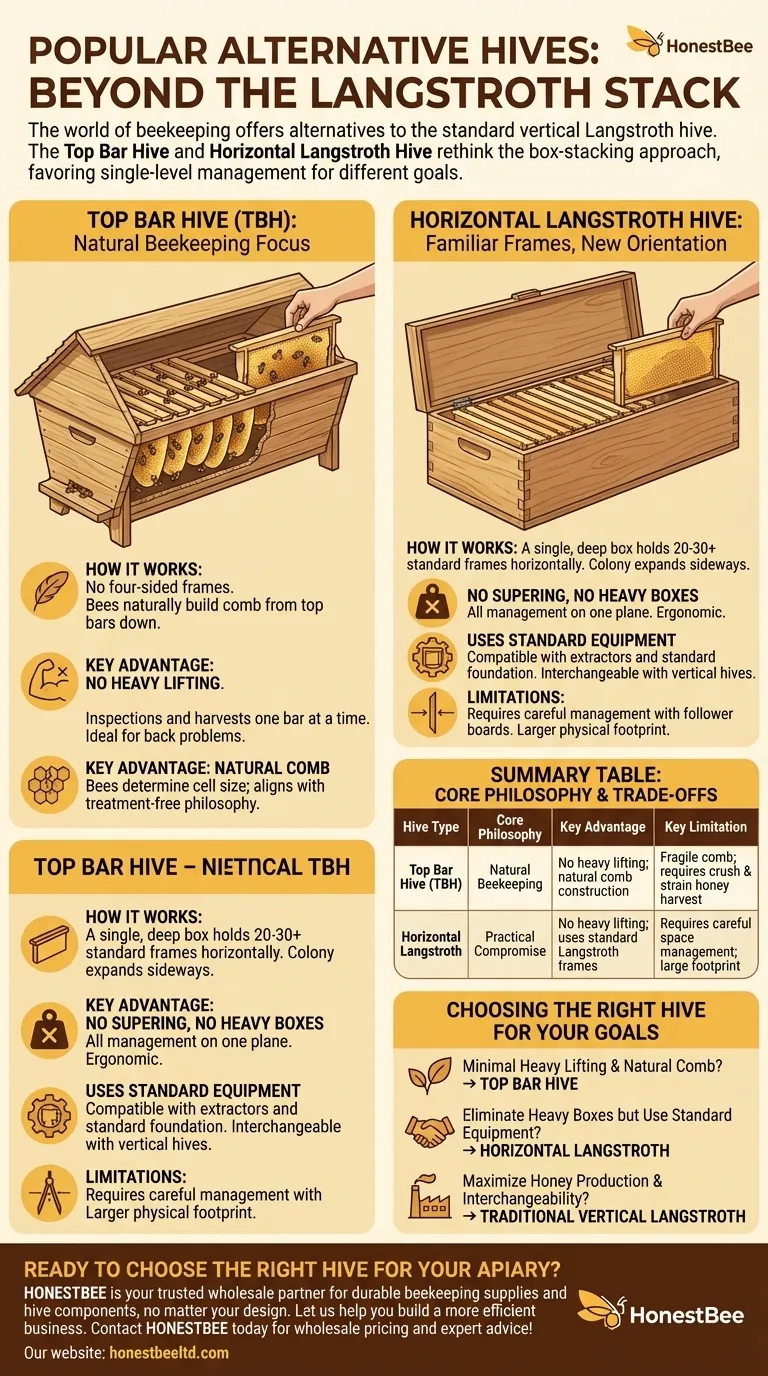Beyond the familiar stack of white boxes, the world of beekeeping offers several alternative hive designs. The two most popular and philosophically distinct alternatives to the standard vertical Langstroth hive are the Top Bar Hive and the Horizontal Langstroth Hive. These designs rethink the vertical, box-stacking approach in favor of single-level management, catering to beekeepers with different physical abilities and beekeeping goals.
The choice between hive types is not about finding the single "best" design, but about aligning the hive's operational philosophy with your goals. Top Bar hives prioritize natural comb and minimal heavy lifting, while Horizontal hives offer the convenience of standard frames in a back-friendly, single-box system.

The Top Bar Hive: A Focus on Natural Beekeeping
A Top Bar Hive (TBH) represents a significant departure from the frame-based system of a Langstroth. It is fundamentally a long, horizontal trough covered with simple wooden bars.
How a Top Bar Hive Works
Instead of four-sided frames, beekeepers place simple "top bars" across the top of the hive body. The bees then build their comb naturally, drawing it down from a small wooden guide or a line of beeswax on the underside of each bar.
Key Advantage: No Heavy Lifting
This is the primary appeal of the TBH. Inspections and honey harvests are done one bar at a time. You never have to lift a heavy box (or "super") that can weigh 50 pounds or more, making it an ideal choice for beekeepers with back problems or limited strength.
Key Advantage: Natural Comb Construction
Bees build their comb to their own desired cell size and shape, without the guide of a pre-made foundation. This aligns with a more "natural" or "treatment-free" beekeeping philosophy that seeks to minimize intervention and let the bees behave as they would in a hollow log.
The Horizontal Langstroth: Familiar Frames, New Orientation
The Horizontal Langstroth—also known as a Layens hive or a "long Langstroth"—is a brilliant compromise. It takes the familiar, standardized frames of a Langstroth hive and arranges them in a single, long box.
How a Horizontal Hive Works
Imagine a standard Langstroth hive turned on its side. It's a single, deep box that can hold 20 to 30 or more frames, all on one level. The colony expands sideways rather than upwards.
Key Advantage: No Supering, No Heavy Boxes
Like the Top Bar Hive, this design completely eliminates the need to lift heavy honey supers. All hive management, from brood inspections to honey harvesting, is done on one horizontal plane, making it extremely ergonomic.
Key Advantage: Uses Standardized Equipment
Because it uses standard Langstroth frames, you retain significant advantages. You can use common honey extractors, purchase standard foundation, and even move frames of bees or honey between your horizontal and vertical hives if you run both systems.
Understanding the Trade-offs
Neither alternative is a perfect replacement for the Langstroth; each comes with its own set of limitations that are critical to understand.
Top Bar Hive Limitations
The natural comb in a TBH is attached only at the top and is notoriously fragile. It can easily break off the bar if handled improperly or on very hot days. Furthermore, you cannot use a standard centrifugal extractor; honey is almost always harvested by cutting the comb from the bar and using the "crush and strain" method.
Horizontal Langstroth Limitations
While convenient, the large, open horizontal space requires careful management. The beekeeper must use "follower boards" (solid dividers) to manage the colony's size and prevent the queen from laying eggs throughout the entire hive, which can make honey harvesting difficult. These hives also have a much larger physical footprint than a vertical stack.
Choosing the Right Hive for Your Goals
Your decision should be guided by your physical abilities, beekeeping philosophy, and primary objectives.
- If your primary focus is minimal heavy lifting and natural comb: The Top Bar Hive is an excellent choice, embracing a less intrusive style of beekeeping.
- If your primary focus is eliminating heavy boxes but using standard equipment: The Horizontal Langstroth offers a practical compromise, keeping familiar frames in a back-friendly design.
- If your primary focus is maximizing honey production and equipment interchangeability: The traditional vertical Langstroth hive remains the industry standard for its efficiency and scalability.
Understanding these core design philosophies empowers you to choose a hive that best serves both your goals and your bees' needs.
Summary Table:
| Hive Type | Core Philosophy | Key Advantage | Key Limitation |
|---|---|---|---|
| Top Bar Hive (TBH) | Natural Beekeeping | No heavy lifting; natural comb construction | Fragile comb; requires crush & strain honey harvest |
| Horizontal Langstroth | Practical Compromise | No heavy lifting; uses standard Langstroth frames | Requires careful space management; large footprint |
Ready to Choose the Right Hive for Your Apiary?
Whether you're a commercial apiary scaling up production or a distributor stocking the latest equipment, HONESTBEE is your trusted wholesale partner. We supply a wide range of durable beekeeping supplies and hive components to support your operation, no matter which hive design you choose.
Let us help you build a more efficient and productive beekeeping business.
Contact HONESTBEE today for wholesale pricing and expert advice!
Visual Guide

Related Products
- Long Langstroth Style Horizontal Top Bar Hive for Wholesale
- HONESTBEE Advanced Ergonomic Stainless Steel Hive Tool for Beekeeping
- Professional Dual-End Stainless Steel Hive Tool for Beekeeping
- Professional 3-Bar Frame Grip with Integrated Hive Tool
- Professional Pneumatic Wire Embedder for Beehive Frames
People Also Ask
- What are the advantages of a top bar hive? Simpler, Bee-Centric Beekeeping for All
- How does the design of a top bar hive benefit beekeepers? Ergonomic & Natural Beekeeping for Hobbyists
- How are entrances designed in top bar hives? Master Beehive Layout for Maximum Honey
- What are the benefits of the top bar hive? A Guide to Ergonomic, Natural Beekeeping
- What are the benefits of a top bar hive? A Natural, Low-Impact Approach to Beekeeping



















